
Newsletter of the Shell Club of Sydney
NSW Branch, The Malacological Society of Australasia Limited ACN 067 894 848
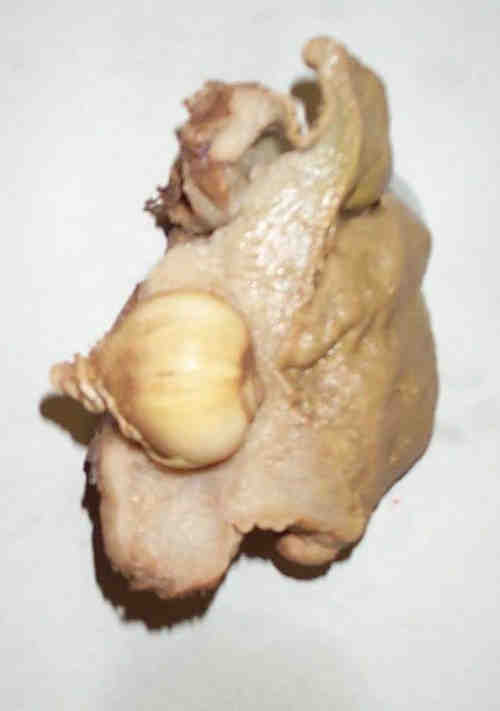
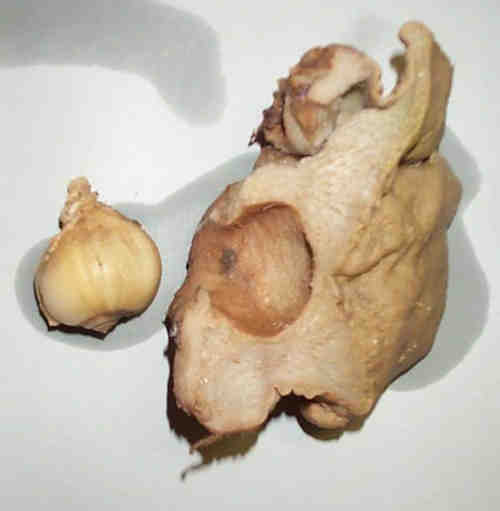
Rapa incurva imbedded in sponge - Noosa Heads, Queensland
Article in this issue by Kev Lamprell
Members News, & Buy, Swap & Sell:
Last weekend Patty, and her daughters, were spotted at Long Reef Sydney. Patty was in heavy discussion with the Ranger. No she was not in trouble, she was photographing sea creatures, and the ranger was on his way scuba diving.
We tried to help her photograph a blue ringed octopus, but it kept darting under rocks at our feet. After Patty left we saw more 'blue ringers' and most were in calm pools where they would have been easy to photograph. Keith & Steve Dean
At the January meeting Ron Moylan displayed a selection of Cypraea leucodon
from his collection. He also brought along the first Cypraea leucodon
found in Australian waters.
It was recently trawled at 300m along with other unusual specimens from a "secret' location 30km east of Swains Reef.
The feeling was, if there was one, there are probably more, and probably additional locations.
The Australian specimen was large. It had softer edges around the spots than Ron's other specimens yet spots were large and well defined.
The club Christmas party excursion to Kurnell generated some interesting finds, even though numbers attending were light on.
Prior to this I did not have any good specimens of Tanea
sagittate. At Kurnell I found one with good markings. (Since Christmas with the low tides I have found a few more, but none as well patterned) - Steve Dean
Hidden Shells
Rapa incurva
By Kev Lamprell
In October this year, Queensland Museum worker Steve Cook while collecting sponge specimens for his research work, was diving in 20 metres of water off the Pinnacle at Tow Shoal, Noosa Heads, Queensland.
Among his sponge specimens he found a shell imbedded in one of the samples.
Steve passed the shell to me for identification, the specimen appears to be
Rapa incurva (Dunker,1852) which, according to Barry Wilson's Australian Shell book, is rarely found in Australia.
The species lives embedded in soft corals or sponges. Because of the difficulty for most collectors to see the shell in its natural habitat, I thought it would be interesting to record the finding with images in the Sydney Sheller.
Dutch Malacological Society
The Dutch Malacological Society (NMV) has a set of web pages that includes descriptions of active research, books, links to Malacologists operating in the region, the Malacological Society, email discussion groups and links to other regional groups and Vita Marina.
Much of the site is only in Dutch, but pages are gradually being duplicated in English.
Never the less the site provides a ready method for quickly getting through to web sites and email contacts related to the bulk of Malacological activity in the region.
"The Dutch Malacological Society (NMV) is meant for everyone who is interested in molluscs (shells, snails, cuttlefish, etc.), amateurs as well as professionals.
The society has existed since 1934 and now counts about 540 members of which about 60 % live in the Netherlands."
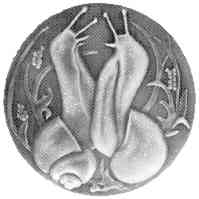
(Logo of the NMV from the web site)
The web site is located at: http://web.inter.nl.net/users/Meijer.T/nmv.htm
Web sites not to be missed.
I am Luigi Raybaudi Massilia, a cowrie collector and the editor of the World Shells Magazine.
I'd like to introduce myself inviting you to visit two brand new sites, reachable at the following addresses:
http://www.raybaudi.com
http://www.worldshells.com
There you can find news, information, articles and photos of many shells. Moreover you will find thousands of shells
for sale/swap and immediately available.
Editor: The raybaudit web site is described on the next page. The worldshells site lists an interesting selection of shells of
all types for sale, as well as articles from the World Shells Magazine. (The picture is from this site)
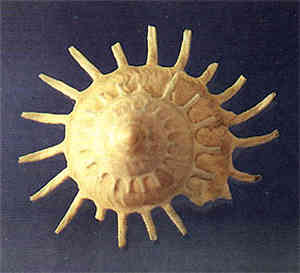
Genus Guildfordia
100,000 Gem Cowries For Sale
Luigi Raybaudi Massilia
The Raybaudi web site introduced above, is amazing, Luigi has decided to sell much of his stock and collection.
The list of Cypraeidae he is selling appears to have anything you would ever want.
There are over 100,000 cowries for sale! Over 90% of the entire stock is purported to be of true gem quality. The number of rare forms of each shell type for sale would suggest this is probably true.
The on-line catalogue currently lists "Cypraeidae A to C". There is an amazing selection of variants of each individual type of specimen.
On the next page is the range of - asellus offered on the site. I chose a common variety as an example to show the range of variants and pricing.
There are also many many rare and unique specimens in the web page lists, so I have included examples of one or two rare but inexpensive and rare but expensive varieties from the web site.
A background of Luigi and his shells extracted from his web site follows:
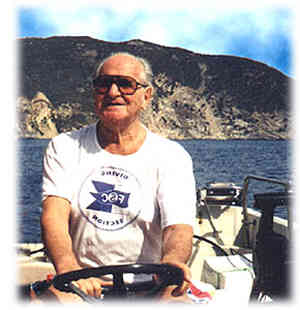
"For over half a century I have been involved with shells. Way back in the 1950s I was already hunting for shells in the Red Sea with my 35 meters yacht "Caroline"!
In these 50 years I have gone round the world at least 10-15 times, with long stays along coasts and around the islands which were the most interesting, from the malacological standpoint, especially those which are now protected (Galapagos, Seychelles, Red Sea, Queensland, Solomons, Tonga, New Hebrides, New Caledonia, etc.).
As a diver, scuba diver, and hookah diver, I have personally collected many hundreds of thousands of shells, and I have purchased a much larger number from natives, from local fishermen and from dealers. What is more, I have also purchased entire commercial stocks and many collections, including some that are very well known and important.
Well, today, for reasons of age (I am over 86 years old), I have decided to do away with my entire stock and part of my collections: a body of material which I believe is still the most interesting, and perhaps the most important in the world.
And so, dear Friends, today you have an unrepeatable chance, a true Golden Opportunity: to complete, enrich, or improve your collection with specimens selected from the Raybaudi Stock-Collection"
(Picture examples from web site)
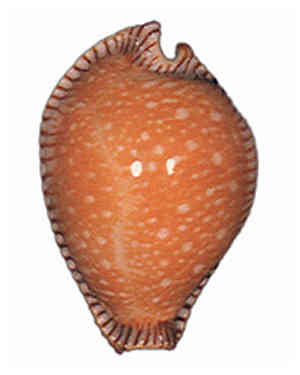
Erosaria guttata surinensis,
Raybaudi 1978
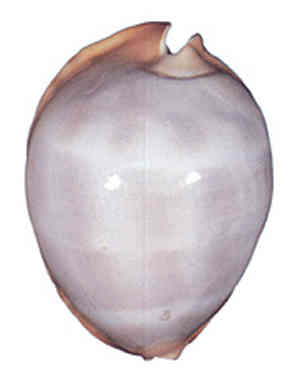
Zoila thersites eburnea,
Raybaudi 1985
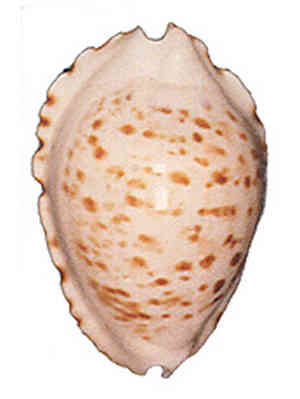
Zoila marginata ketyana,
Raybaudi 1978
Conus swainsoni
A rare cone from New Caledonia
November 1999
By Vincent CRAYSSAC
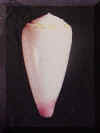 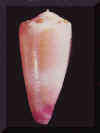
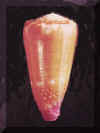 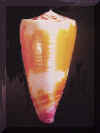
Evolution from juvenile to adult.
Conus swainsoni is a member of the C.planorbis group and is described from New Caledonia.
Description:
Shell cream white with orange brown to brown radial flames and large zones of patches of bright orange to orange brown on the body whorl, leaving the white ground colour as an irregular spiral band below midbody or only as a row of isolated white flecks. Body whorl besides this with fine dark brown spiral threads, in adult specimens 23-30, in juvenile more or less missing. Base deep violet. Juvenile specimens either with the same colours as adult ones or, more commonly, unicoloured pinkish-white with brown flecks only on the spire and with a purple base. Shell rather high, solid, with low spire and angled, smooth shoulder and a deep suture. Protoconch with at least 2 whorls and protruding as a knob from the teleconch.
Average size is around 40mm.
Habitat:
It inhabits detritic bottoms consisting of coarse muddy sand with pink calcareous algae and red algae, in a depth situated around 20m. The biotope is in influence of strong tidal currents. Other species in the same biotope are :
C.connectens, C.planorbis, C.consor, C.imperialis, C.varius. We find in general that specie near Noumea.
Comparison & Discussion : C.swainsoni is very similar to
C.connectens. The main difference is with juvenile specimens. Swainsoni are mostly pinkish-white coloured instead of the more brownish coloration of the juvenile
C.connectens. In that group, related to C.planorbis, C.swainsoni is easily distinguishable
Tahiti -Shells
For Sale

Hubert Sagnieres has built a website for shells collectors and divers who find
shells. Its aim is to provide a direct link between divers and shell collectors.
It is for divers or collectors to sell their shells, on the world on the web, and for the others to buy safely what they need.
If you are a diver, a shell finder, or a shell collector you can send an e-mail list of what you have for sale. They will put them on the net for you ... FREE OF CHARGE. Send pictures, if you have some or just your list. To help identify species pictures are often included, but not necessarily the specimen for sale. If you are unsure of what to charge they will help you to find the fair market price.
Goods are sent directly from seller to buyer, but payment goes via Tahitishells to ensure no one is ripped off. They charge a 10% commission on the sale.
Buyers and collectors can email what they are looking for and Tahitishells will try to source it. Or you can just buy what you see on the web site.
The web site is located at:
www.tahitishells.com
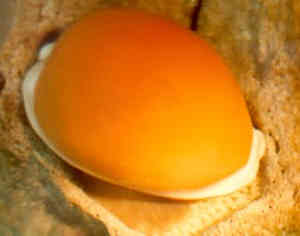
Cypraea Aurantium sitting on its eggs.
Domain Forwarding
Get rid of those long hard to remember web addresses.
By Steve Dean
I have changed my advertisement in the Sheller for Easynet, the Internet Service Provider Company I own. It now focuses on 'Domain Forwarding.'
As this is a fairly recent trend on the Net, this article is to explain how anyone with a web site can take advantage of forwarding.
There is nothing more annoying than being told about a good web site, and having to type in an extremely long address to get to it. Some are so long you have to write them down or you cannot remember them while travelling.
Many government and institutional web servers have long lists of sub folders for each activity within each department, so individual researchers end up with very long web addresses for their allocated web space.
The Dutch Malacological Society (NMV) web address on page three of this newsletter is an example of one that is on the verge of being too long. It does not fit on a single line in
teh column format of the printed Sheller (even if the text were smaller)
There are many good research sites with extremely long, hard to remember web addresses that would span several lines.
Usually the researcher or organization has no choice but to store their web pages at the address they have been allocated, and in many cases the location is convenient for communication with, and use by, other staff and other departments in the same organization.
When you also want the site to be available to a wider audience, a shorter and more descriptive web address would be of benefit.
It is possible to purchase a short domain name that better describes the subject matter and is easy to remember. This domain is then hosted with a third party ISP.
This does not necessarily mean your web site needs to be moved or copied to the third party ISP. Some ISPs offer 'Transparent Domain Forwarding' where the domain is pointed to your existing web site.
When the public type in a simple web address of the form www.domain.suffix they actually end up at the real web site (with the long address).
Email associated with the domain can often be directed to your existing email address.
In the case of the example above the NMV would probably get two additional domains one that was succinct in English and one that conveyed the message in Dutch, both being short. These would both be pointed to the existing web site.
Those that knew the web site where it originally was could still access it at the old address, as could staff working on it. (Any associated databases, CGI, secure servers etc. would not change.) Others would
use the short simple web address for access.
Many ISPs do not offer Domain Forwarding, or limit associated email forwarding, and some charge monthly domain hosting fees as though the domain was not forwarded.
Others like my company, Easynet, have very low fees for hosting of forwarded domains. We can host your domain and forward it to your existing web site anywhere in the world. We can also recommend short domains for you and even purchase them for you.
In a future issue of the Sheller I plan to discuss types of domains, to show you how to get short effective names with matching suffixes.
Shell Club minutes
22/01/2000. (Summary)
The meeting was opened by P. Jansen at 2:02pm.
Patty welcomed everyone and wished all a Happy New Year. Patty apologised to Adrian Browne, in his absence , for not being able to contact him about the changes to the November meeting which was adjourned to Winston Ponder's home for a BBQ Christmas party.
Our own Christmas function at Kurnell was not well attended; discussions are needed to decide what people want to attend. Field trips are obviously not exciting enough.
Field Trip Reports:
C. Barnes showed some current acquisitions from Little Bay, Kurnell and a secret North Shore location.
Patty found a Phyllocoma speciosa Angus, 1871 at Kurnell.
New Acquisitions:
Ron Moylan borrowed a live taken Cypraea leucodon (Broderip, 1828) from Queensland about 30 km east of Swain's Reef. This is believed to be the first example of this species taken in Australian waters. Ron also displayed a
Cypraea friendii thersites form contraria Iredale, 1935. This shell was taken in 12 m of water in Bass Strait and is usually only found in deep water.
There was also an Australian Cypraea langfordi form moretonensis Kuroda, 1938 which is worth about $US3500 due to its rarity.
Thanks to Ron for allowing us to observe these magnificent and rare shells.
Book Reviews:
P. Jansen with the latest edition of La Conchiglia which contains articles on Liviadae, Triviadae and Colubraria.
A special issue containing Ryostoma sp; land snails of south east Asia, Thailand, Malaysia and Cambodia.
"Recent Xenophoridae" by Kurt Kreigh and Axel Alf from Conch Books is now available with a forward by Winston Ponder. The book costs $99, has lots of Australian content and full colour photographs including bases of shells for easier identification.
Conchological Iconography- Strombs is available . There are over 100 colour plates with variations and different angles, comprehensively covering the Genus through to the mid 1990's. Vita Marina December 1999 edition and the newsletter Spirula.
General Business:
A positive response was received from Tanya Ekert (Functions Manager RELC) about our continued use of the meeting rooms at the club. Michael Keats had a query about membership and purchase of the shell poster from Christopher Lamare and Debbie Riethmueller of Newcastle. Michael proposed that the information sheet distributed during the Second National Shell Show be updated and sent out as replies to membership enquiries.
Peter Pineaar mentioned his concern that the cost of the Sydney Sheller was
reducing the bank balance and although we just broke even in 1999 he would like to see a little more money coming in to keep the branch solvent. Peter moved a motion:
"That the annual subscription be increased to $25 from the 1st of July 2000." Seconded by Ron Moylan. The meeting voted unanimously in favour of the motion.
Ron mentioned that David Tarrant from Coffs Harbour will be attending the February meeting and would like to see examples of Cypraeidae from Sydney.
Meeting Dates:
It was decided that the March meeting would be cancelled due to the attendance of many of the members at the Third National Shell Show in Adelaide at that date. It was also decided to cancel the December booking with RELC as this is normally the Christmas function.
Chris Barnes to write to the Functions Manager advising of these decisions and to offer thanks for the continued use of a meeting room.
Ron mentioned that all the Perpetual Trophies had been received by the South Australian Branch of the MSA and are presently being engraved with the original winners names.
Presentations:
Stephanie Clark and Patty Jansen organised a Shell Quiz. Great fun was had by all.
Meeting closed at 2:52pm.
C. & K. Barnes, Secretary
|














